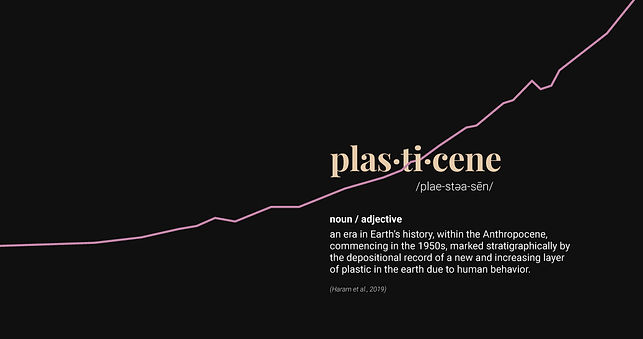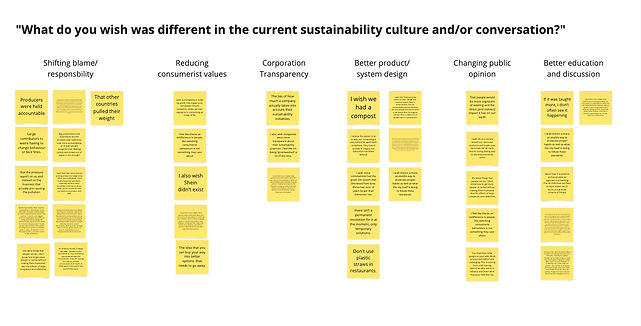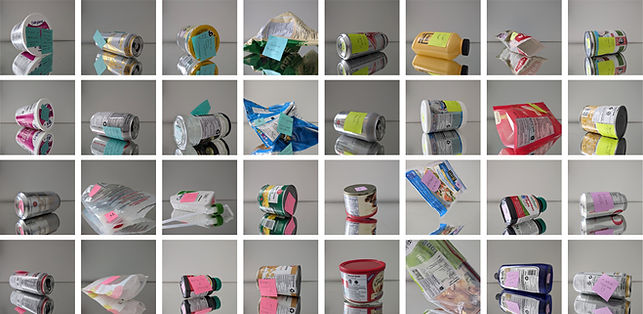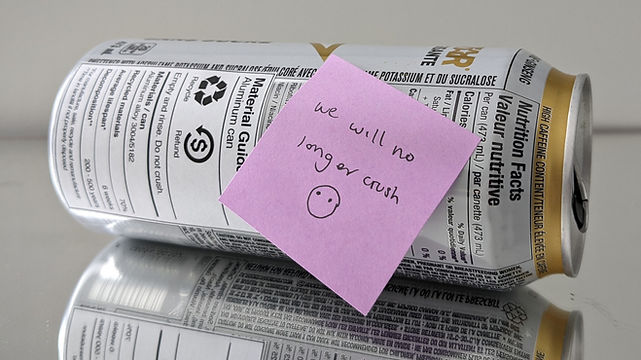Material Matters
CRITICAL DESIGN / INFORMATION DESIGN
A labelling system that communicates the lifecycle of single-use materials.
As a work of critical design, Material Matters is a conceptual product catalogue that introduces the production and life-cycle of single-use materials. The catalogue serves as a medium for sparking dialogue on material economy, mass production, and consumer culture.
DATE
Sep 2023 – Apr 2024
Independent
TEAM
ROLE
UX Designer &
Researcher
CONTEXT
Capstone Project, Bachelor of Design

DESIGN QUESTION
How might design research identify opportunities for intervention in the material economy?
Self-selected for Bachelor of Design capstone project
STAGE 0
Topic Selection
A PASSION PROJECT
Driven by a personal passion for sustainability and circularity, I wish to introduce more transparency into the production and use of single-use materials, with the overarching goal of transitioning to a circular economic model.
THE CIRCULAR ECONOMY
Prior research projects into the circular economy helped support the initial research for this project. You can see some of my research on circular design here.
Sample from early presentation slides
STAGE 1
Discover & Define
LITERATURE REVIEW
My research began on the issue of material culture and sustainability. Our time in history is being marked by a material crisis in which the effect of consumerist culture and linear economic practices are leaving permanent depositional records in our environment.
Due to this, our period in history is termed the "plasticene." (Haram et al., 2020)

DIGITAL SURVEY
To begin the data collection process, I constructed a digital survey with the goal of casting a broad net to acquire baseline data.
AFFINITY DIAGRAM
To review the qualitative survey data, affinity diagrams were used to group similar themes in responses.
TOOLS USED
-
Google Forms
-
Miro

Sample affinity diagram for "What do you feel is the most impactful thing you do concerning environmental sustainability?"

Sample affinity diagram for "What do you with was different in the current sustainability culture and/or conversation?"
KEY FINDINGS
1
Generally, most respondents reported wanting to positively contribute to sustainable development.
2
Even the most intrinsically motivated individuals noted systemic boundaries inhibitting their sustainable intentions
3
Many respondants expressed heightened emotional responses
including feelings of frustration, fear, anger, and hopelessness
4
Without prompting, numerous respondants stated they wished
there was a shift of responsibiltiy onto the system and producers.
CULTURAL PROBE
The probe was designed to get a more intimate account of participants’ perspectives on the topic, the material habits they have, and how the domestic environment may support or inhibit these factors. It involved an interview and spatial analysis of the participant's domestic space.
KEY INSIGHT
One of the greatest pain points identified by participants was the lack of clarity and understanding of the system. This lack of clarity became particularly harmful in those who also did not claim to care about the topic. In these respondents, a lack of system clarity fueled their apathy and resulted in improper disposal habits.

Original sketch rendered with a participant during spatial analysis
"We are convinced that waste is a design flaw."
STAGE 2
Develop
DESIGN CONCEPT
I will be developing a disposal labelling system for single-use material products. This solution prioritizes increasing system clarity for consumers and while also adding responsibility for producers to increase transparency in their production practices.
As a prototype, this solution will serve as a work of critical design intended to spark dialogue on the state of material practices.
VISUAL STRATEGY
Taking a departure from a traditional sustainable (greenwashed) visual language, this system will instead leverage the semiotic value of existing informational systems such as nutrition facts, WHIMIS, and cigarette warning labels.

Rapid prototypeing sketch
Early render sample
PROJECT COMPONENTS
1
Label Content
Establishing the library of content that may be included in labels
-
Research
-
Item/Material selection
-
Iconography
Label Design System
Designing modular labeling system that can be applied to a wide range of packaging products
-
Typographic analysis
-
Mockup drafting (physical and digital)
-
User testing
2
3
Product Catalogue
Presenting the label system in a physical product catalogue
-
Product photography
-
Publication design
-
Printing and assembly
LABEL PROTOTYPES
Early label prototypes explored various types of label content and different ways to communicate the information.
TOOLS USED
-
Pen and Paper
-
Adobe Illustrator

First batch of label prototypes for user testing session
CATALOGUE DEVELOPMENT
To house the label system, I began to develop a product catalogue (of sorts), providing a stage for these banal objects of mass-production.
TOOLS USED
-
Pen and Paper
-
Adobe InDesign
-
Studio Photography


Studio photography setup for catalogue images
STAGE 3
User Test
TEST STRUCTURE
I developed a testing workshop where I invited my peers to assess and dispose of a collection of physical materials, some of which with my prototyped label.
GOALS
-
Receive feedback for final development.
-
Understand user response, experience and feelings toward the label information.
-
Determine the effectiveness of the prototyped labels.

Workshop structure ideation sketch
PHASE 0 / PREP
-
Participants were arranged into groups by drawing numbers from a box.
-
Each station was prepared with a double-sided workboard, sticky notes, and pens.
-
In a central location were three disposal sites: "landfill", "recycling", and "other."
PHASE 1 / BASELINE
-
Each group were provided with a bag of various single-use material products.
-
Groups were asked to assess and dispose of the materials as they saw fit, applying a sticky note to indicate any special actions.
PHASE 2 / PROTOTYPE
-
The same as phase 1, this time with products that have the prototyped labels attached.
PHASE 3 / REFLECTION
-
Participants were invited to reflect on the experience, using the workboard provided to record their ideas.
-
At this stage, I also walked around the space and engaged with participants, taking observational notes.


Collection of items prepared for and assessed by workshop participants
KEY FINDINGS
No one questioned the validity of the information presented to them on the labels.
The similarity to known systems was noted as both a pro and a con depending on context.
Many participants felt that they learned something new through the experience alone.
WORKSHOP FEEDBACK
The tactile nature of this workshop received high acclaim. Given the physical nature of the topic, the structure seemingly garnered better engagement and more valuable insights than if I had opted for a 2-dimensional critique format.

Note from participant group in phase 2
STAGE 4
Deliver
LABEL SYSTEM
The final label system was developed for key materials types we encounter daily in single-use products: plastic, metal, glass, and composites.
The label presents information in an objective way, inviting the audience to arrive at their own critiques.
AUDIENCE RECEPTION
Noted as being particularly impactful was the contrast of "average use time" and "decomposition time." The contrast of there two realities highlighted that an object in use for just 1 hour may be fated to persist for 500 years in our environment.
















